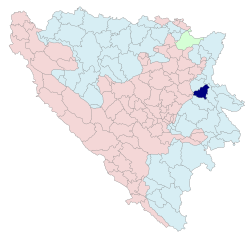Vlasenica
Vlasenica (Serbian Cyrillic: Власеница) is a town and municipality located in Republika Srpska, an entity of Bosnia and Herzegovina. As of 2013, it has a population 11,467 inhabitants, while the town of Vlasenica has a population of 7,228 inhabitants.
Vlasenica Власеница | |
|---|---|
Town and municipality | |
| Vlasenica | |
Vlasenica | |
 Coat of arms | |
 Location of Vlasenica within Bosnia and Herzegovina | |
| Coordinates: 44°11′N 18°56′E | |
| Country | |
| Entity | |
| Government | |
| • Mayor | Dragoslav Todorović (SDS) |
| Area | |
| • Total | 448.14 km2 (173.03 sq mi) |
| Population (2013 census) | |
| • Total | 11,467 |
| • Density | 26/km2 (66/sq mi) |
| Time zone | UTC+1 (CET) |
| • Summer (DST) | UTC+2 (CEST) |
| Area code(s) | 56 |
| Website | www |
Vlasenica church
Demographics
Population
| Population of settlements – Vlasenica municipality | ||||||||||||||
|---|---|---|---|---|---|---|---|---|---|---|---|---|---|---|
| Settlement | 1879. | 1885. | 1895 | 1910. | 1921. | 1931. | 1948. | 1953. | 1961. | 1971. | 1981. | 1991. | 2013. | |
| Total | 19,420 | 23,085 | 24,927 | 30,928 | 28,865 | 37,532 | 26,623 | 30,498 | 33,817 | 11,467 | ||||
| 1 | Cerska | 1,409 | 689 | |||||||||||
| 2 | Grabovica | 537 | 342 | |||||||||||
| 3 | Gradina | 755 | 395 | |||||||||||
| 4 | Neđeljišta | 738 | 354 | |||||||||||
| 5 | Pustoše | 552 | 208 | |||||||||||
| 6 | Vlasenica | 4,121 | 7,283 | 3,047 | 3,976 | 6,000 | 7,909 | 7,228 | ||||||
Ethnic composition
| Ethnic composition – Vlasenica town | |||||||
|---|---|---|---|---|---|---|---|
| 2013. | 1991. | 1981. | 1971. | ||||
| Total | 7,228 (100,0%) | 7,909 (100,0%) | 6,000 (100,0%) | 3,976 (100,0%) | |||
| Bosniaks | 4,800 (60,69%) | 3,435 (57,25%) | 2,774 (69,77%) | ||||
| Serbs | 2,743 (34,68%) | 1,793 (29,88%) | 1,124 (28,27%) | ||||
| Yugoslavs | 242 (3,060%) | 578 (9,633%) | 5 (0,126%) | ||||
| Others | 98 (1,239%) | 22 (0,367%) | 25 (0,629%) | ||||
| Croats | 26 (0,329%) | 18 (0,300%) | 12 (0,302%) | ||||
| Roma | 98 (1,633%) | 25 (0,629%) | |||||
| Montenegrins | 28 (0,467%) | 7 (0,176%) | |||||
| Albanians | 22 (0,367%) | 3 (0,075%) | |||||
| Hungarians | 3 (0,050%) | ||||||
| Slovenes | 2 (0,033%) | ||||||
| Macedonians | 1 (0,017%) | 1 (0,025%) | |||||
| Ethnic composition – Vlasenica municipality | |||||||
|---|---|---|---|---|---|---|---|
| 2013. | 1991. | 1981. | 1971. | ||||
| Total | 11,467 (100,0%) | 17,761 (100,0%) | 30,498 (100,0%) | 26,623 (100,0%) | |||
| Serbs | 7,589 (66,18%) | 6,311 (35,53%) | 13,531 (44,37%) | 13,431 (50,45%) | |||
| Bosniaks | 3,763 (32,82%) | 10,897 (61,35%) | 15,337 (50,29%) | 12,881 (48,38%) | |||
| Others | 84 (0,733%) | 249 (1,402%) | 131 (0,430%) | 151 (0,567%) | |||
| Croats | 31 (0,270%) | 32 (0,180%) | 44 (0,144%) | 42 (0,158%) | |||
| Yugoslavs | 272 (1,531%) | 978 (3,207%) | 17 (0,064%) | ||||
| Roma | 352 (1,154%) | 53 (0,199%) | |||||
| Montenegrins | 81 (0,266%) | 28 (0,105%) | |||||
| Albanians | 33 (0,108%) | 14 (0,053%) | |||||
| Hungarians | 5 (0,016%) | 1 (0,004%) | |||||
| Slovenes | 4 (0,013%) | 3 (0,011%) | |||||
| Macedonians | 2 (0,007%) | 2 (0,008%) | |||||
Economy
The following table gives a preview of total number of registered people employed in legal entities per their core activity (as of 2018):[1]
| Activity | Total |
|---|---|
| Agriculture, forestry and fishing | 108 |
| Mining and quarrying | - |
| Manufacturing | 257 |
| Electricity, gas, steam and air conditioning supply | 86 |
| Water supply; sewerage, waste management and remediation activities | 56 |
| Construction | 28 |
| Wholesale and retail trade, repair of motor vehicles and motorcycles | 217 |
| Transportation and storage | 31 |
| Accommodation and food services | 55 |
| Information and communication | 9 |
| Financial and insurance activities | 17 |
| Real estate activities | - |
| Professional, scientific and technical activities | 20 |
| Administrative and support service activities | 4 |
| Public administration and defense; compulsory social security | 170 |
| Education | 133 |
| Human health and social work activities | 107 |
| Arts, entertainment and recreation | 10 |
| Other service activities | 32 |
| Total | 1,340 |
Notable people
- Lazar Jovanović, 19th-century manuscript writer
- Derviš Sušić
- Flory Jagoda
- Vedad Ibišević
- Fahrudin Kuduzović
- Nedžmin Ambešković, strongman
- Salko Zildžić, boxer, Party of Democratic Action politician
- Isnam Taljić, writer
See also
- Municipalities of Republika Srpska
- Massacres of Serbs in Rašića Gaj
Notes
- "Cities and Municipalities of Republika Srpska" (PDF). rzs.rs.ba. Republika Srspka Institute of Statistics. 25 December 2019. Retrieved 31 December 2019.
This article is issued from Wikipedia. The text is licensed under Creative Commons - Attribution - Sharealike. Additional terms may apply for the media files.